CHEVROLET TRACKER 1997 Manual PDF
Manufacturer: CHEVROLET, Model Year: 1997, Model line: TRACKER, Model: CHEVROLET TRACKER 1997Pages: 388, PDF Size: 20.12 MB
Page 71 of 388
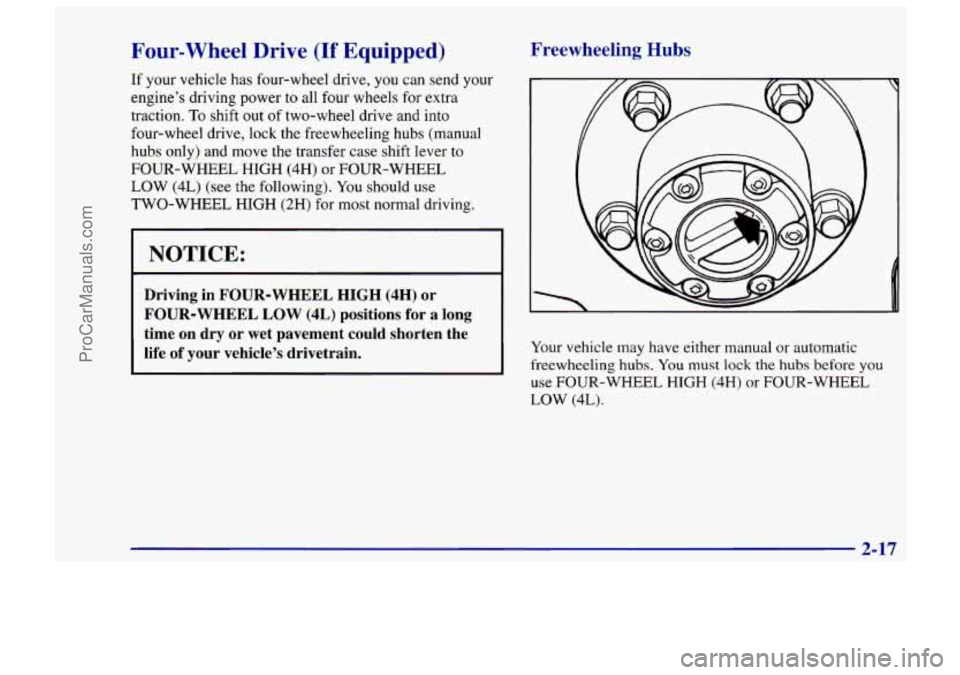
Four-wheel Drive (If Equipped)
If your vehicle has four-wheel drive, you can send your
engine’s driving power to all four wheels for extra
traction.
To shift out of two-wheel drive and into
four-wheel drive, lock the freewheeling hubs (manual
hubs only) and move the transfer case shift lever to
FOUR-WHEEL HIGH (4H) or FOUR-WHEEL
LOW (4L) (see the following). You should use
TWO-WHEEL
HIGH (2H) for most normal driving.
NOTICE:
Driving in FOUR-WHEEL HIGH (4H) or
FOUR-WHEEL
LOW (4L) positions for a long
time on dry or wet pavement could shorten the
life of your vehicle’s drivetrain.
Freewheeling Hubs
Your vehicle may have either manual or automatic
freewheeling hubs. You must
lock the hubs before you
use FOUR-WHEEL HIGH (4H) or FOUR-WHEEL
LOW
(4L).
2-17
,
ProCarManuals.com
Page 72 of 388
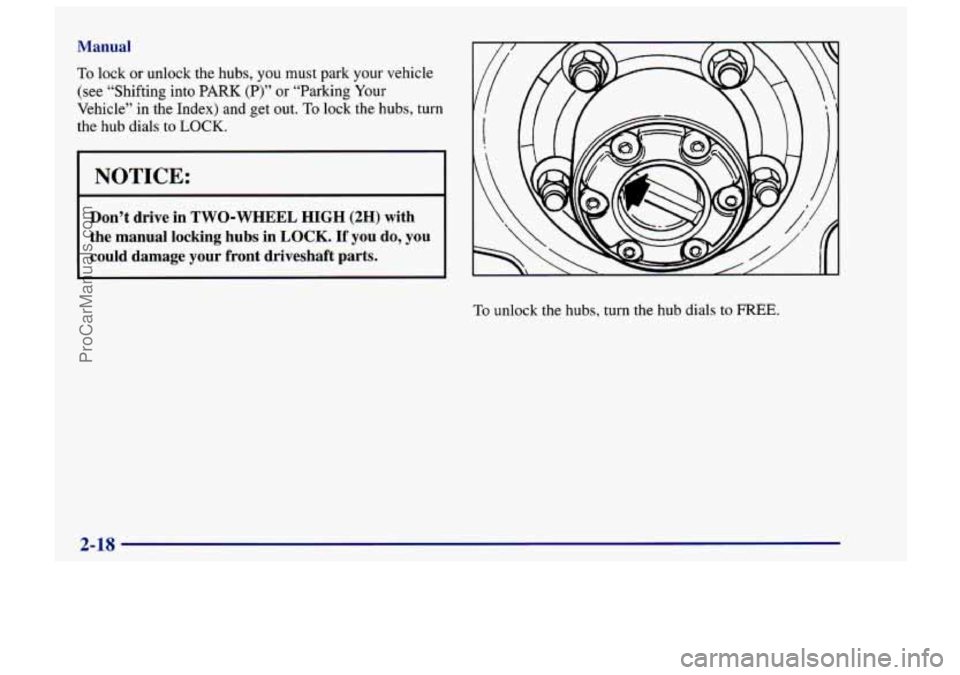
Manual
To lock or unlock the hubs, you must parK your vehicle
(see “Shifting into
PARK (P)” or “Parking Your
Vehicle” in the Index) and get out.
To lock the hubs, turn
the hub dials to
LOCK.
NOTICE:
Don’t drive in TWO-WHEEL HIGH (2H) with
the manual locking hubs in
LOCK. If you do, you
could damage your front driveshaft parts.
To unlock the hubs, turn the hub dials to FREE.
2-18
ProCarManuals.com
Page 73 of 388
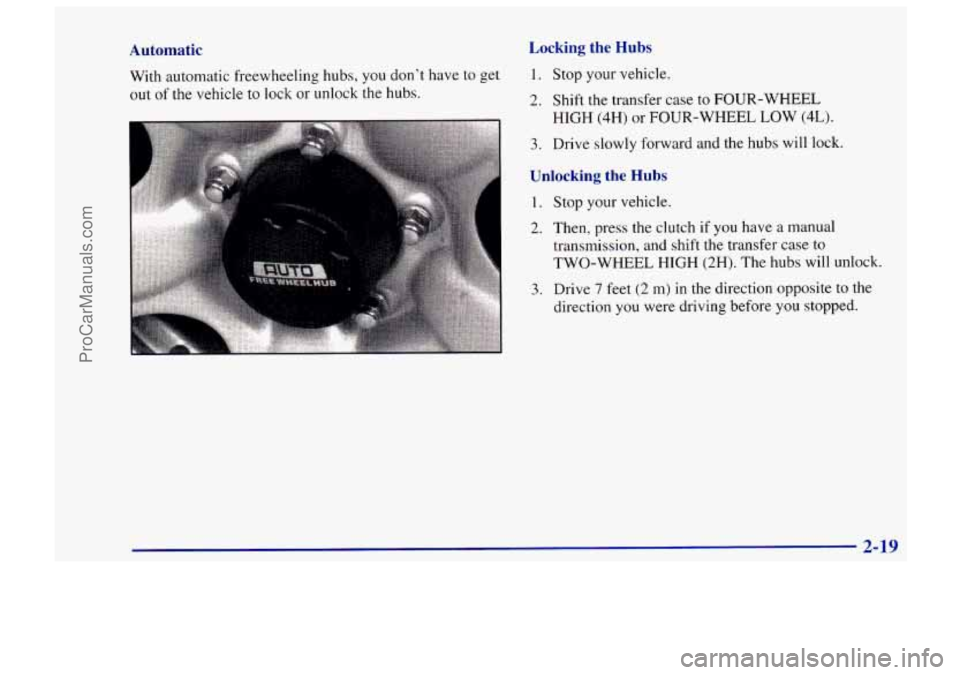
Automatic
With automatic freewheeling hubs, you don’t have to get
out
of the vehicle to lock or unlock the hubs.
Locking the Hubs
1. Stop your vehicle.
2. Shift the transfer case to FOUR-WHEEL
HIGH
(4H) or FOUR-WHEEL LOW (4L).
3. Drive slowly forward and the hubs will lock.
Unlocking the Hubs
1. Stop your vehicle.
2. Then, press the clutch if you have a manual
transmission, and shift the transfer case to
TWO-WHEEL HIGH (2H). The hubs will unlock.
3. Drive 7 feet (2 m) in the direction opposite to the
direction you were driving before you stopped.
2-19
ProCarManuals.com
Page 74 of 388
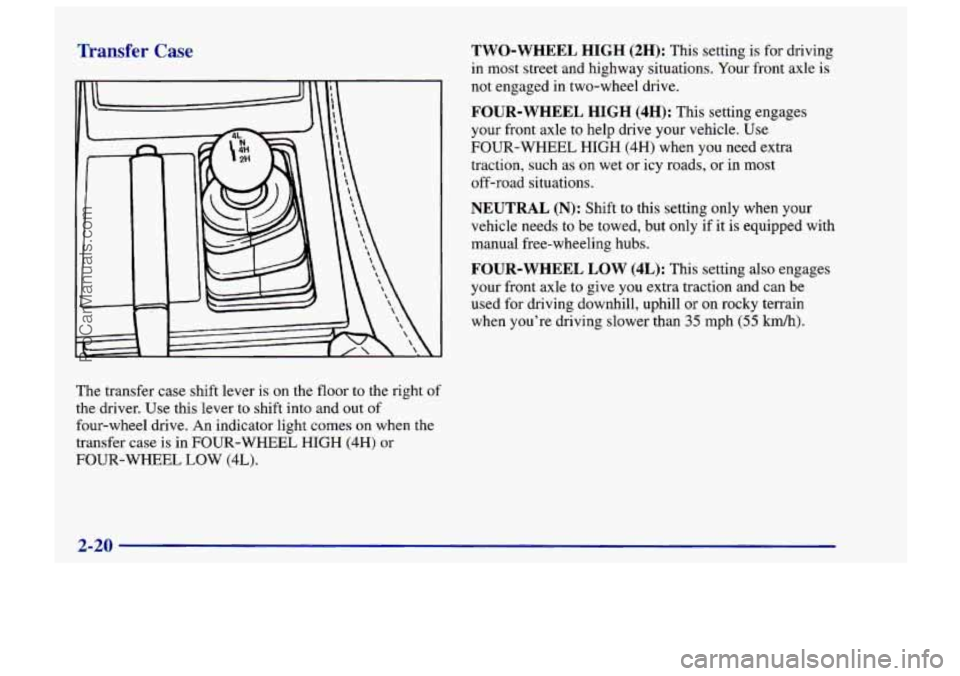
Transfer Case
L
i
The transfer case shift lever is on the floor to the right of
the driver. Use this lever to shift into and out of
four-wheel drive. An indicator light comes on when
the
transfer case is in FOUR-WHEEL HIGH (4H) or
FOUR--EL
LOW (4L).
TWO-WHEEL HIGH (2H): This setting is for driving
in most street and highway situations. Your front axle is
not engaged in two-wheel drive.
FOUR-WHEEL HIGH (4H): This setting engages
your front axle to help drive your vehicle. Use
FOUR-WHEEL HIGH
(4H) when you need extra
traction, such as on wet or icy roads, or in most
off-road situations.
NEUTRAL (N): Shift to this setting only when your
vehicle needs to be towed, but only
if it is equipped with
manual free-wheeling hubs.
FOUR-WHEEL LOW (4L): This setting also engages
your front axle to give you extra traction and can be
used for driving downhill, uphill or on rocky terrain
when you're driving slower than
35 mph (55 km/h).
2-20
ProCarManuals.com
Page 75 of 388
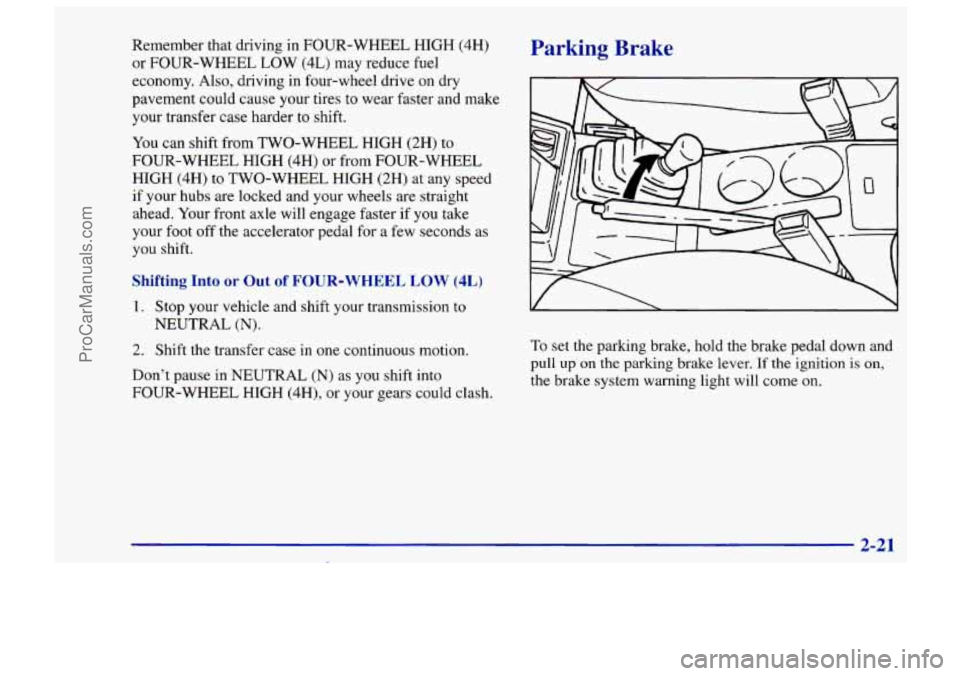
Remember that driving in FOUR-WHEEL HIGH (4H)
or FOUR-WHEEL LOW (4L) may reduce fuel
economy. Also, driving in four-wheel drive on dry
pavement could cause your tires to wear faster and make
your transfer case harder to shift.
You can shift from TWO-WHEEL HIGH (2H) to
FOUR-WHEEL HIGH
(4H) or from FOUR-WHEEL
HIGH (4H) to TWO-WHEEL HIGH (2H) at any speed
if your hubs are locked and your wheels are straight
ahead. Your front axle will engage faster if you take
your foot off the accelerator pedal for a few seconds as
you shift.
Shifting Into or Out of FOUR-WHEEL LOW (4L)
1. Stop your vehicle and shift your transmission to
NEUTRAL (N).
2. Shift the transfer case in one continuous motion.
Don’t pause in NEUTRAL
(N) as you shift into
FOUR-WHEEL
HIGH (4H), or your gears could clash.
To set the parking brake, hold the brake pedal down and
pull
up on the parking brake lever. If the ignition is on,
the brake system warning light will come on.
2-21
ProCarManuals.com
Page 76 of 388
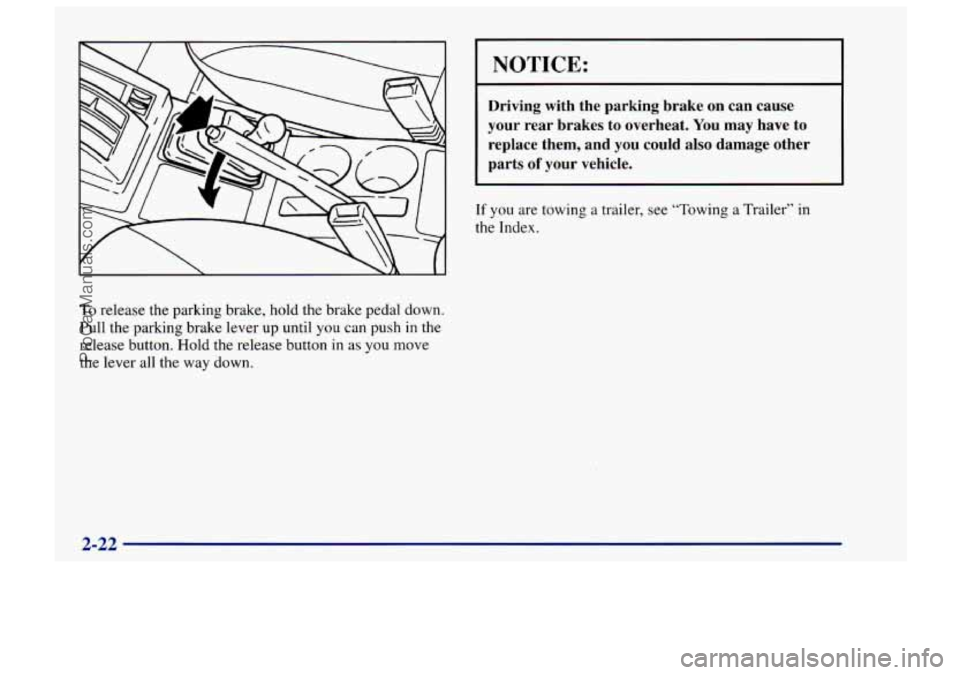
To release the parking brake, hold the brake pedal down.
Pull the parking brake lever up until
you can push in the
release button. Hold the release button in as you move
the lever
all the way down.
NOTICE:
Driving with the parking brake on can cause
your rear brakes to overheat. You
may have to
replace them, and you could also damage other
parts
of your vehicle.
If you are towing a trailer, see “Towing a Trailer” in
the Index.
2-22
ProCarManuals.com
Page 77 of 388
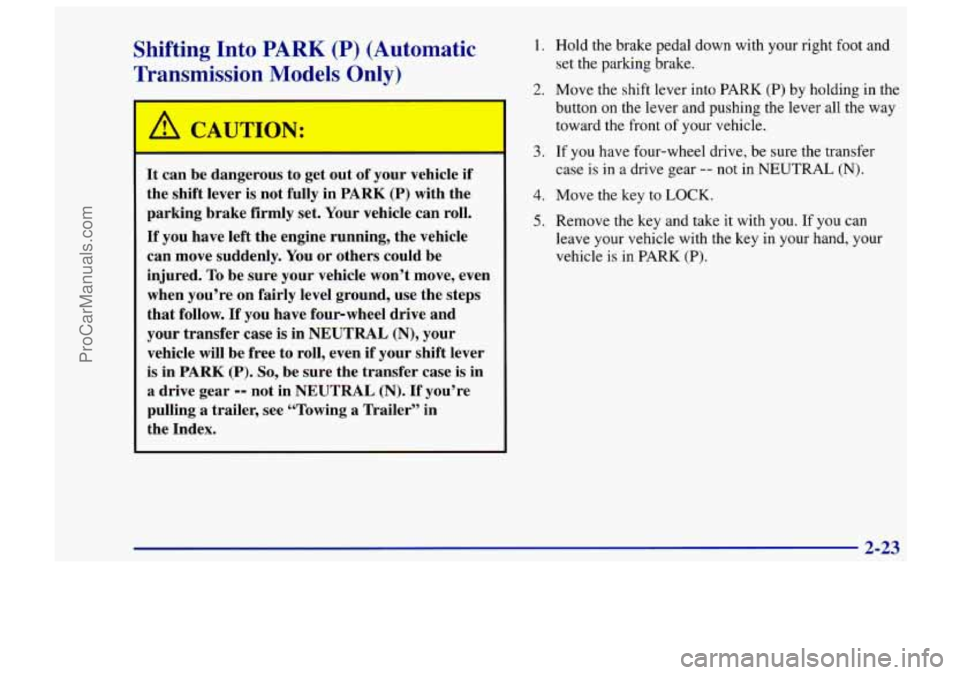
Shifting Into PARK (P) (Automatic
Tran ~ nission Models Only)
It can be dangerous to get out of your vehicle if
the shift lever is not fully in PARK (P) with the
parking brake firmly set. Your vehicle can roll.
If you have left the engine running, the vehicle
can move suddenly. You or others could be
injured.
To be sure your vehicle won’t move, even
when you’re on fairly level ground, use the steps
that follow.
If you have four-wheel drive and
your transfer case is in
NEUTRAL (N), your
vehicle will be free to roll, even
if your shift lever
is in
PARK (P). So, be sure the transfer case is in
a drive gear -- not in NEUTRAL (N). If you’re
pulling a trailer, see “Towing a Trailer” in
the Index.
1. Hold the brake pedal down with your right foot and
2. Move the shift lever into PARK (P) by holding in the
button
on the lever and pushing the lever all the way
toward the front
of your vehicle.
set
the parking brake.
3. If you have four-wheel drive, be sure the transfer
case
is in a drive gear -- not in NEUTRAL (N).
4. Move the key to LOCK.
5. Remove the key and take it with you. If you can
leave your vehicle with the key
in your hand, your
vehicle is in
PARK (P).
2-23
ProCarManuals.com
Page 78 of 388

Leaving Your Vehicle With the Engine
Running (Automatic Transmission
Models Only)
I
It can be dangerous to leave your vehicle with the
engine running. Your vehicle could move
suddenly if the shift lever is not fully in
PARK (P)
with the parking brake firmly set. If you have
four-wheel drive and your transfer case is in
NEUTRAL (N), your vehicle will be free to roll,
even if your shift lever is in
PARK (P). So be sure
the transfer case is
in a drive gear -- not in
NEUTRAL (N). And, if you leave the vehicle with
the engine running, it could overheat and even
catch fire. You or others could be injured. Don’t
leave your vehicle with the engine running unless
you have to.
Torque Lock (Automatic Transmission)
If you are parking on a hill and you don’t shift your
transmission into PARK (P) properly, the weight
of the
vehicle may put too much force
on the parking pawl in
the transmission. You may find it difficult to pull the
shift lever out
of PARK (P). This is called “torque lock.”
To prevent torque lock, set the parking brake and then
shift into PARK
(P) properly before you leave the
driver’s seat. To find out how, see “Shifting Into
PARK (P)” in the Index.
When you are ready to drive, move the shift lever out of
PARK
(P) before you release the parking brake.
If torque lock does occur, you may need to have another
vehicle push yours a little uphill to take some of the
pressure from the parking pawl in the transmission,
so
you can pull the shift lever out of PARK (P).
2-24
ProCarManuals.com
Page 79 of 388
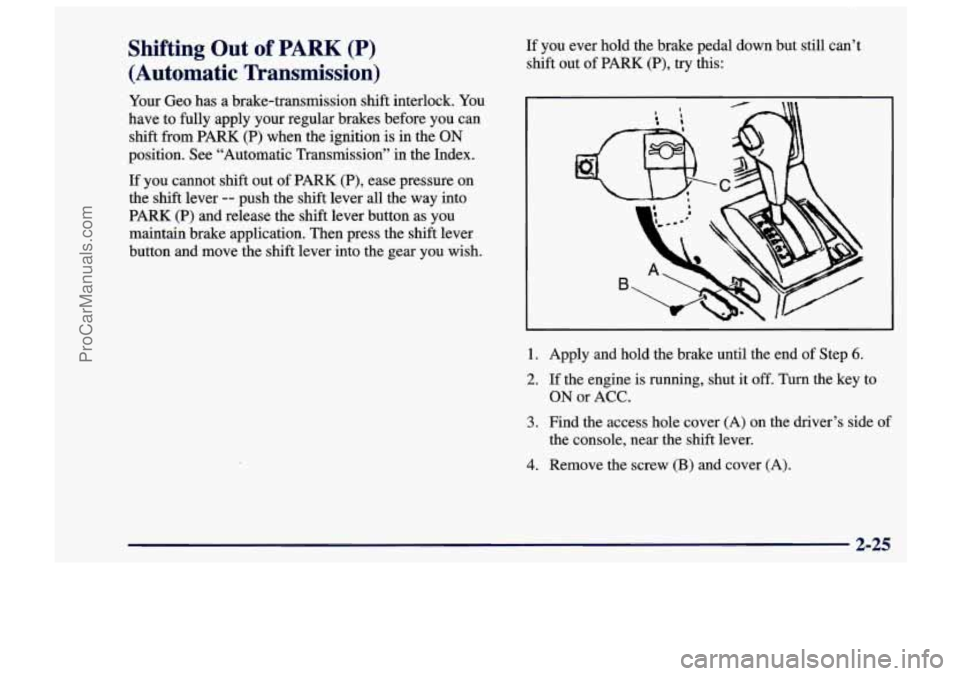
Shifting Out of PARK (P)
(Automatic Transmission)
Your Geo has a brake-transmission shift interlock. You
have to fully apply your regular brakes before you can
shift from PARK
(P) when the ignition is in the ON
position. See “Automatic Transmission” in the Index.
If you cannot shift out of PARK. (P), ease pressure on
the shift lever
-- push the shift lever all the way into
PARK (P) and release the shift lever button as you
maintain brake application. Then press the shift lever
button and move the shift lever into the gear you wish.
If you ever hold the brake pedal down but still can’t
shift out of PARK
(P), try this:
1. Apply and hold the brake until the end of Step 6.
2. If the engine is running, shut it off. Turn the key to
ON or ACC.
3. Find the access hole cover (A) on the driver’s side of
the console, near the shift lever.
4. Remove the screw (B) and cover (A).
2-25
ProCarManuals.com
Page 80 of 388
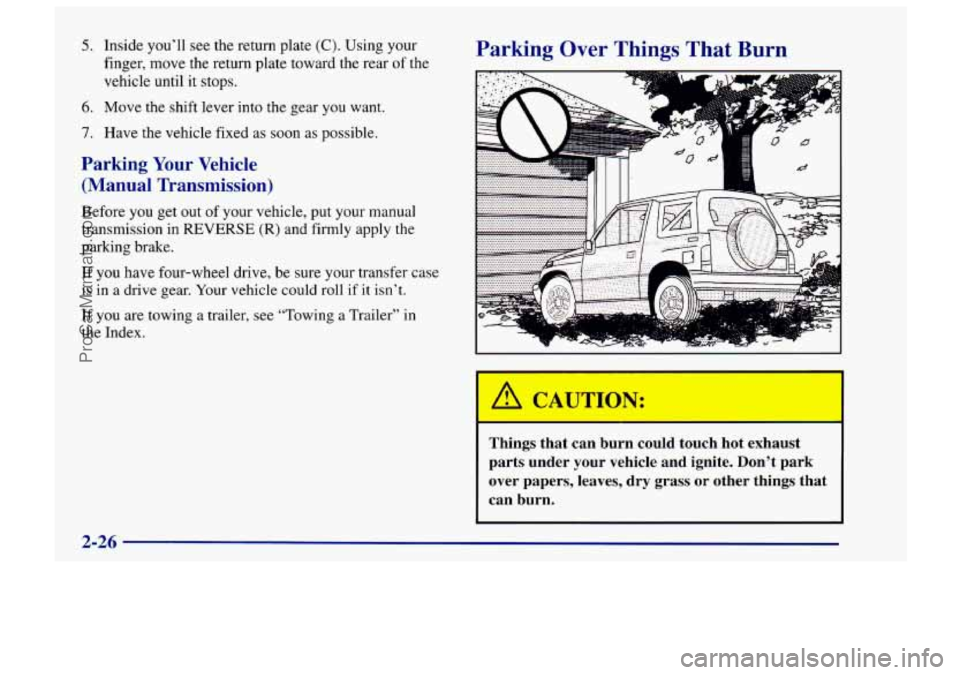
5. Inside you'll see the return plate (C). Using your
finger, move the return plate toward the rear
of the
vehicle until it stops.
6. Move the shift lever into the gear you want.
7. Have the vehicle fixed as soon as possible.
Parking Your Vehicle
(Manual Transmission)
Before you get out of your vehicle, put your manual
transmission in
REVERSE (R) and firmly apply the
parking brake.
If you have four-wheel drive, be sure your transfer case
is in a drive gear. Your vehicle could roll if it isn't.
If you are towing
a trailer, see "Towing a Trailer" in
the Index.
Parking Over Things That Burn
I -w---- I .. . . . . . . . . . u --
A
I
Things that can burn could touch hot exhaust
parts under your vehicle and ignite. Don't park
over papers, leaves, dry grass or other things that
can burn.
2-26
ProCarManuals.com